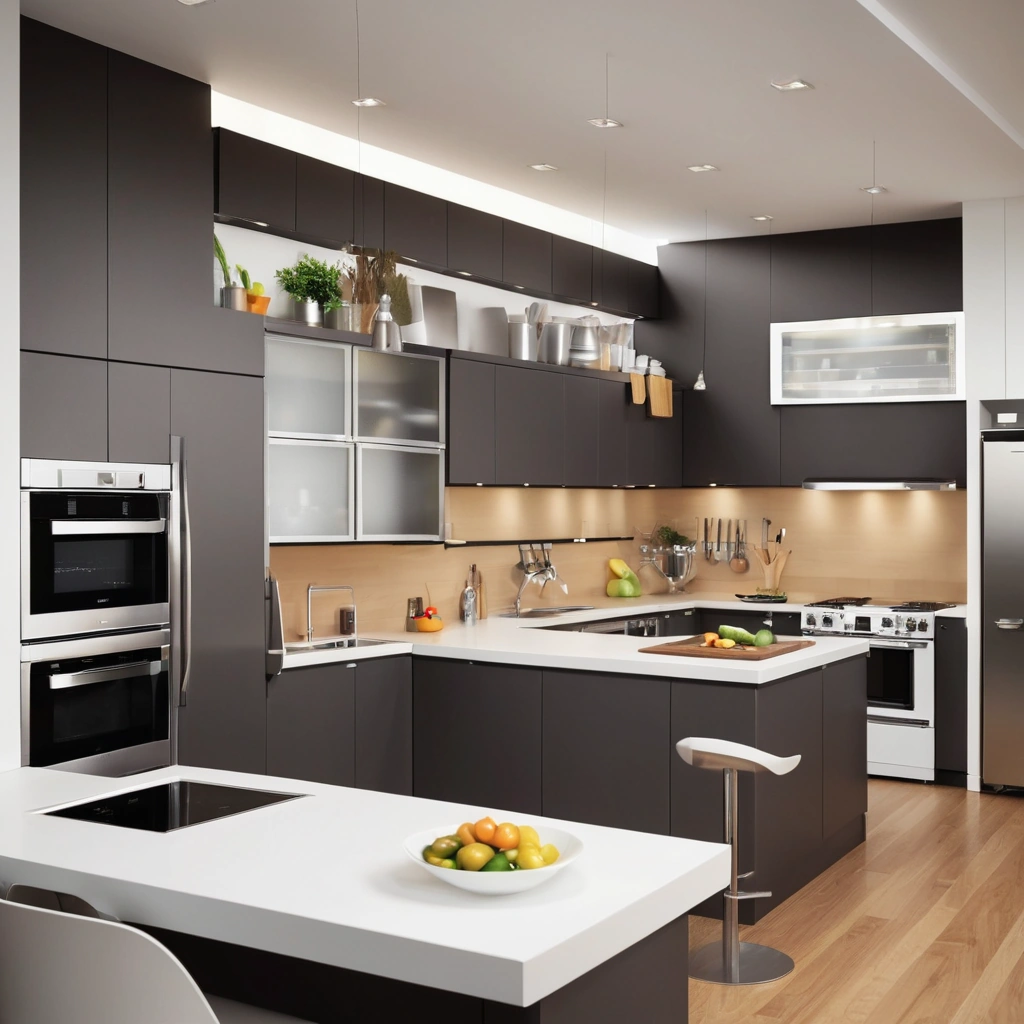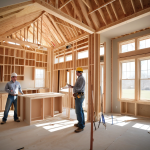Mastering the Modern Kitchen: Advanced Layout and Workflow Optimization for Efficiency and Ergonomics
Introduction: The Modern Kitchen Imperative
The kitchen, often hailed as the heart of the home, is more than just a space for cooking; it’s a hub of activity, a gathering place, and a reflection of our lifestyle. However, a poorly designed kitchen can quickly become a source of frustration, hindering efficiency and making even simple tasks feel cumbersome. In today’s fast-paced world, optimizing your kitchen layout and workflow is paramount. This comprehensive guide will delve into the principles of advanced kitchen design, focusing on ergonomics, efficiency, and the seamless integration of technology to create a culinary haven that is both functional and enjoyable.
Whether you’re a seasoned chef or a casual cook, mastering these techniques will transform your kitchen into a workspace where culinary creativity can flourish. Modern kitchen design transcends mere aesthetics; it’s about creating a highly functional and intuitive space. Optimizing your kitchen workflow involves strategically arranging key areas – the cooking zone, cleaning zone, and storage zone – to minimize unnecessary movement and maximize productivity. The traditional working triangle, while a useful starting point, has evolved into a more nuanced understanding of kitchen zones, accounting for multiple cooks and diverse cooking styles.
For example, a dedicated baking zone with a mixer lift, pull-out shelves for ingredients, and a nearby oven can significantly enhance the workflow for avid bakers. Similarly, incorporating smart appliances, such as a refrigerator that suggests recipes based on available ingredients, can streamline meal planning and reduce food waste. Kitchen ergonomics plays a crucial role in ensuring comfort and preventing strain, especially during extended cooking sessions. Thoughtful consideration of counter heights, appliance placement, and storage solutions can significantly improve the overall kitchen experience.
For instance, incorporating adjustable-height countertops allows users of different heights to comfortably work in the kitchen. Pull-out shelves and drawers eliminate the need to bend and reach for items in deep cabinets, reducing strain on the back and knees. Moreover, adhering to ADA compliance guidelines ensures that the kitchen is accessible to individuals with disabilities, promoting inclusivity and universal design principles. A well-designed kitchen prioritizes both functionality and the well-being of its users. The integration of smart home automation is revolutionizing the way we interact with our kitchens.
Smart appliances, such as voice-controlled ovens, refrigerators with inventory management, and automated coffee makers, offer unprecedented convenience and efficiency. Imagine preheating your oven remotely while you’re on your way home from work, or receiving an alert when you’re running low on milk. Smart lighting systems can automatically adjust brightness based on the time of day or the task at hand, creating a more comfortable and energy-efficient environment. Furthermore, integrated smart home systems can control various aspects of the kitchen, from temperature and ventilation to security and entertainment, all from a single interface. Embracing technology can transform your kitchen into a truly intelligent and responsive space.
Decoding Kitchen Layouts: U-Shaped, L-Shaped, Galley, Island, and Peninsula
The foundation of an efficient kitchen lies in its layout, a critical element that dictates both functionality and flow. Each kitchen layout type offers unique advantages and disadvantages, contingent on the available space, the homeowner’s cooking style, and the integration of smart appliances. Understanding these nuances is paramount for optimizing kitchen workflow and maximizing usability, especially when considering a kitchen remodel. Beyond aesthetics, the layout directly impacts kitchen ergonomics, influencing ease of movement, reach, and overall comfort during food preparation and cleanup.
Careful consideration should be given to how the chosen layout facilitates the principles of the working triangle, connecting the cooking, cleaning, and storage zones for seamless operation. The U-shaped kitchen, often considered the gold standard for larger spaces, provides ample counter space and abundant kitchen storage on three sides, effectively creating a dedicated and highly efficient cooking zone. This design minimizes unnecessary steps and allows for multiple users to work simultaneously without congestion. The L-shaped kitchen, versatile and adaptable, presents a balanced layout suitable for small to medium-sized spaces, offering two perpendicular work areas that can be customized to accommodate various cooking styles.
Its open design promotes social interaction, making it ideal for homes where the kitchen serves as a central gathering point. When considering kitchen design, it’s important to remember that the L-shape can be easily adapted to incorporate an island, further enhancing functionality and storage. Galley kitchens, characterized by two parallel countertops, are a space-saving and efficient solution, ideally suited for smaller homes or apartments where maximizing every square inch is crucial. This design promotes a linear kitchen workflow, streamlining food preparation and cleanup.
Island kitchens, featuring a freestanding island, elevate both the aesthetic appeal and functional capacity of the space, providing additional prep space, storage, and even a secondary sink or cooktop. The island serves as a focal point and social hub, fostering interaction between the cook and guests. Peninsula kitchens, similar to island kitchens but attached to a wall, offer a semi-open layout, creating a natural division between the kitchen and other living areas while still providing the benefits of an island, such as extra counter space and storage.
These layouts are particularly useful in smaller homes where a full island might not be feasible. Furthermore, when planning a kitchen remodel, accessibility is a key consideration. Incorporating ADA compliance principles ensures that the kitchen is usable by individuals with disabilities, promoting inclusivity and long-term usability. This includes features such as adjustable-height countertops, roll-under sinks, and ample maneuvering space. Thoughtful kitchen design also encompasses optimizing kitchen ergonomics to reduce strain and fatigue, such as strategically placing appliances and utilizing pull-out shelves and drawers for easy access to items. By carefully evaluating the available space, cooking habits, and accessibility needs, homeowners can select the optimal kitchen layout to create a space that is both efficient and enjoyable to use for years to come.
The Working Triangle/Zones: Optimizing Workflow for Maximum Productivity
The traditional working triangle, while a useful starting point, has evolved into a more nuanced understanding of kitchen zones to maximize efficiency in modern kitchen design. These zones—cooking, cleaning, and storage—should be strategically positioned to minimize unnecessary movement and optimize kitchen workflow. The cooking zone, the heart of culinary activity, benefits from proximity to both prep areas and essential cooking tools. Consider incorporating smart appliances like induction cooktops with integrated timers or ovens with pre-programmed settings to streamline the cooking process.
A well-designed cooking zone reduces physical strain and enhances the joy of cooking. Data from the National Kitchen and Bath Association (NKBA) indicates that homeowners prioritizing efficient cooking zones report a 25% reduction in meal preparation time. The cleaning zone, typically centered around the sink and dishwasher, should be thoughtfully planned to facilitate efficient cleanup. Locating it adjacent to waste disposal and dish storage minimizes steps and prevents clutter. Incorporating ergonomic features such as pull-out waste containers and adjustable-height dishwashers enhances kitchen ergonomics and reduces strain.
Furthermore, integrating a smart faucet with voice activation can streamline tasks like filling pots or rinsing dishes. The storage zone, encompassing the refrigerator, pantry, and other storage solutions, requires careful consideration of accessibility and organization. Placing frequently used items within easy reach and utilizing smart kitchen storage solutions like pull-out shelves and pantry organizers maximizes space and minimizes wasted effort. Moving beyond the traditional triangle, consider overlapping zones and multi-functional spaces, especially in smaller kitchen layouts.
For example, a kitchen island can serve as both a prep area and a casual dining space, blurring the lines between zones and maximizing functionality. The integration of smart technology further enhances zoning efficiency. Smart refrigerators can track inventory and suggest recipes based on available ingredients, while smart ovens can be preheated remotely, reducing wait times. By carefully considering individual cooking habits and tailoring the space accordingly, homeowners can create a kitchen that is not only aesthetically pleasing but also highly efficient and ergonomic. Remember that ADA compliance also plays a key role; ensuring adequate clearances and accessible storage solutions makes the kitchen usable for everyone, regardless of mobility. Ultimately, optimized kitchen zones lead to a smoother, more enjoyable cooking experience.
Ergonomics, Accessibility, and Storage Solutions: Designing for Comfort and Functionality
Beyond basic layout principles, ergonomics and accessibility are critical for creating a kitchen that is both comfortable and functional for all users, directly impacting kitchen workflow. Kitchen ergonomics focuses on optimizing the interaction between the user and the kitchen environment to reduce strain and improve efficiency. This involves careful consideration of counter heights, appliance placement, and the accessibility of storage solutions. According to a study by the National Kitchen and Bath Association (NKBA), poor kitchen design can lead to increased fatigue and a higher risk of injuries, highlighting the importance of incorporating ergonomic principles into kitchen design.
The goal is to create a space where tasks can be performed comfortably and efficiently, minimizing unnecessary movements and strain. Thoughtful kitchen design contributes to a more enjoyable and productive cooking experience. ADA (Americans with Disabilities Act) compliance ensures that the kitchen is accessible to individuals with disabilities, incorporating features such as adjustable-height countertops, roll-under sinks, and ample maneuvering space. However, ADA compliance isn’t just about meeting legal requirements; it’s about creating a kitchen that is inclusive and usable by everyone, regardless of their physical abilities.
Kitchen remodels should consider universal design principles, which aim to create spaces that are accessible and comfortable for people of all ages and abilities. This includes features like pull-down shelves, lever-handled faucets, and contrasting color schemes to aid visibility. Incorporating these elements not only enhances accessibility but also improves the overall functionality and usability of the kitchen for all users. Storage solutions, such as pull-out shelves, drawer organizers, and vertical dividers, maximize storage capacity and improve accessibility to stored items, contributing significantly to efficient kitchen storage and optimized kitchen zones.
Smart appliances can also play a role in improving accessibility, such as refrigerators with adjustable shelves and ovens with выдвижные racks. Effective storage solutions are essential for maintaining an organized and clutter-free kitchen, which directly impacts workflow. Consider incorporating specialized storage for specific items, such as spice racks, pot lid organizers, and knife blocks. The placement of these storage solutions should be carefully considered in relation to the working triangle to minimize unnecessary movement and improve efficiency.
Appliance placement significantly impacts workflow. For example, placing the microwave above the oven can create a bottleneck during meal preparation, while strategically positioning the refrigerator near the entrance of the kitchen improves accessibility for quick snacks and drinks. Consider the height and reach of all users when planning appliance placement and storage solutions. Smart appliances, while offering convenience, should also be integrated thoughtfully into the kitchen layout to optimize workflow. For instance, a smart oven with remote preheating capabilities can save time during meal preparation, but its placement should still align with the cooking zone for maximum efficiency. By carefully considering appliance placement and incorporating smart technology, you can create a kitchen that is both efficient and enjoyable to use.
The Role of Technology: Smart Appliances and Integrated Systems
Technology is revolutionizing the modern kitchen, offering unprecedented opportunities to enhance kitchen workflow and efficiency. Smart appliances, such as voice-activated ovens capable of preheating to precise temperatures on command, refrigerators with AI-powered inventory management systems that minimize food waste, and automated coffee makers programmable via smartphone, streamline cooking and simplify daily tasks. These innovations directly impact kitchen design by influencing appliance placement and the overall kitchen layout. Integrated smart home systems allow for remote control of lighting, temperature, and even appliance operation, creating a personalized and energy-efficient kitchen environment.
Imagine preheating your oven on the drive home, ensuring it’s ready the moment you walk through the door. This level of integration not only saves time but also contributes to a more seamless and enjoyable cooking experience, a key consideration in advanced kitchen workflow optimization. Consider the integration of smart technology early when planning your kitchen remodel. Voice-activated faucets, for example, can significantly improve hygiene and efficiency during food preparation, allowing for hands-free operation when handling raw ingredients.
Smart lighting systems can adjust brightness and color temperature to create the perfect ambiance for both cooking and dining, enhancing kitchen ergonomics by reducing eye strain and improving visibility. Beyond individual appliances, consider the potential of networked systems. Smart sensors can monitor humidity and temperature, automatically adjusting ventilation to prevent mold growth – a crucial aspect of kitchen design often overlooked. The possibilities are endless, but careful planning, including a detailed assessment of your needs and a clear understanding of how each technology will integrate into your daily routine, is essential to ensure seamless integration and avoid unnecessary complexity.
One of the most impactful advancements lies in the integration of smart technology with kitchen storage solutions. Imagine cabinets that automatically open with a gentle touch or voice command, revealing perfectly organized contents illuminated by intelligent lighting. These features significantly enhance kitchen ergonomics, particularly for individuals with limited mobility or strength. Furthermore, smart storage systems can track inventory, alerting you when supplies are running low and even automatically reordering items through integrated online platforms. This level of automation not only saves time and effort but also contributes to a more efficient and streamlined kitchen workflow.
When considering smart appliances, prioritize those that seamlessly integrate with your existing kitchen zones and support your cooking style. For example, a smart oven with a built-in camera can allow you to monitor cooking progress remotely, freeing you up to focus on other tasks within the kitchen. Data points from the National Kitchen and Bath Association (NKBA) consistently show an increasing demand for smart kitchen features, with homeowners prioritizing convenience, energy efficiency, and accessibility. Expert commentary emphasizes the importance of considering the long-term implications of technology investments.
While the initial cost of smart appliances may be higher, the potential savings in energy consumption, reduced food waste, and increased convenience can often justify the investment over time. Furthermore, integrating smart technology can increase the overall value of your home, making it a worthwhile consideration for those planning a kitchen remodel. Ensure that your chosen smart appliances are compatible with your existing smart home ecosystem and that you have a reliable internet connection to support their functionality. Finally, remember to prioritize user-friendliness and ease of maintenance when selecting smart kitchen technologies.
Conclusion: Your Kitchen Optimization Checklist
Planning or renovating a kitchen for optimal kitchen layout and workflow requires careful consideration of numerous factors, extending beyond mere aesthetics to encompass advanced principles of efficiency and ergonomics. This checklist serves as a strategic guide, prompting a deep dive into the interconnected aspects of kitchen design. Define your cooking style and needs with granularity, considering not just the frequency of cooking but also the complexity of dishes prepared and the number of individuals typically cooking simultaneously.
Assess your available space and budget realistically, factoring in potential structural modifications and the long-term return on investment associated with high-quality materials and smart appliances. Choose the appropriate kitchen layout (U-shaped, L-shaped, galley, island, or peninsula) based on a thorough understanding of your spatial constraints and workflow preferences. Optimize the working zones (cooking, cleaning, and storage) for maximum productivity, paying close attention to the distances between key appliances and prep areas. The classic working triangle, while a useful starting point, should be reimagined as interconnected kitchen zones that reflect modern cooking habits.
Incorporate kitchen ergonomics design principles to minimize strain and maximize comfort, considering factors such as countertop heights, reach distances, and task lighting. Ensure ADA compliance if necessary, not only to meet legal requirements but also to create a universally accessible and inclusive kitchen space. Select kitchen storage solutions that maximize space and accessibility, incorporating pull-out shelves, drawer organizers, and vertical storage systems. Strategically place appliances for optimal kitchen workflow, considering the proximity of the refrigerator to the prep area and the placement of the dishwasher near the sink.
Integrate smart technology to enhance convenience and efficiency, exploring the potential of voice-activated controls, automated lighting systems, and smart appliances that streamline cooking and cleaning tasks. Consider lighting, ventilation, and aesthetics as integral components of the overall kitchen design, ensuring that the space is not only functional but also visually appealing and comfortable to use. Remember, a well-designed kitchen is an investment in your home and your quality of life, yielding tangible benefits in terms of increased efficiency, reduced stress, and enhanced enjoyment of the cooking experience. A consultation with kitchen design professionals, specializing in advanced kitchen layout and workflow optimization, is crucial for personalized guidance and ensuring a successful kitchen remodel.


